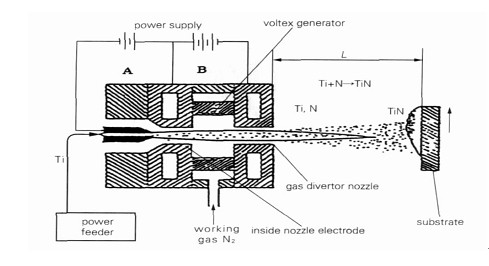

current position:Information and data>reactive plasma spray
Reactive plasma spraying is the result of a further improvement on vacuum plasma spraying. In this method, a reactive gas (such as N2) is added to the plasma jet at the nozzle outlet during the vacuum plasma spraying process, and the reactive gas interacts with the sprayed particles in the heating process. There are new spawns.
For example, TiN coating can be obtained by this method, which is obtained by spraying titanium powder and injecting N2. Its working principle is shown in the figure. TiN has the characteristics of high melting point, high hardness, wear resistance and corrosion resistance, and also has excellent electrical conductivity and superconductivity.
 Figure 9 Schematic diagram of reactive plasma spraying
Figure 9 Schematic diagram of reactive plasma spraying
The preparation of TiN coatings by reactive plasma spraying overcomes the shortcomings of traditional physical or chemical vapor deposition (PVD and CVD) processes to prepare TiN coatings, which have the disadvantages of low deposition rate and too thin coating thickness. Nanocrystalline TiN coatings can be prepared. Thickness up to 500µm.
Before and after plasma spraying
Portal Pretreatment: In conventional thermal spraying processes, the substrate needs to be degreasing and mainly sandblasted with diamond grit. The Protal pretreatment process uses a high-energy laser beam to interact with the surface of the substrate to reduce the oxide layer and other contamination before the collision between the substrate and the molten particles. The use of only a short pulse of 10ns enables the first batch of atomic layer ablation on the surface of the substrate to obtain no Contaminated surfaces, its working principle is shown in the figure. This pretreatment process before spraying can obtain relatively good adhesion of the coating without roughening the surface.
Hot information

